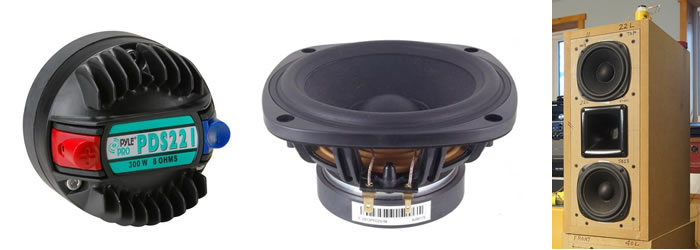The Sparrow-MTM is the D’Appolito version of SB Acoustics 5″ plastic frame drivers. It is a bass reflex of 22 liters, with two SB13PFC25-04 mid-woofers flanking a PRV Audio Wave Guide between them. This wave guide has a coverage of 45°x45° and accepts screw threaded 1″ compression divers at the rear. In this instance, I decided to use a Pyle PDS221, which is cheap and surprisingly good.
RAW Frequency Response of 2 units of SB13PFC25-04
Fig 1 – Mic at 1 meter, tweeter axis, 1/12th octave smoothing. Measurements below 400Hz are Nearfield.
Fig 1 shows the RAW response of two units of SB13PFC25-04. With the Sparrow-MTM, I opted for the 4 ohms version of the SB13PFC because I want to wire them in series for a nominal impedance of 8 ohms. If I had used two 8 ohms mid-woofers, I’ll have to wire them in parallel and they would probably drop below 4 ohms. I try to avoid that as much as possible. Most power amplifiers don’t like speakers with less than 4 ohms impedance.
Crossing the SB13PFC25-04 with WG 11-25/PDS221
Fig 2 – Low Pass of SB13PFC25-04 and High Pass of WG 11-25/PDS221
I was rather concerned with the cone breakup of the SB13PFC in Fig 1. I was hoping that I would not need to use a LCR network to tame the peak at 5.5kHz. That would have added to the cost. Fortunately, after some adjustments, the low pass filter did suppressed the cone breakup, enough to prevent it from interfering with the treble (Blue plot in Fig 2).
The PDS221/WG 11-25 horn, on the other hand, presented a different set of problems. It is imperative that for proper summation, the roll-off slopes of the the two drivers be as smooth as possible. I tested different filter orders with the horn and eventually decided on the Red plot in Fig 2. Astute readers will notice the symmetry in the high pass and low pass slopes.
Reversed Null Frequency Response of Sparrow-MTM
Fig 3 – Frequency Response of Sparrow-MTM with PDS221wired in reversed phase
In order to check how well the SB13PFC25 and the WG 11-25 horn are crossing, I wired the PDS221 in reversed phase. The result is a beautiful deep null at about 3kHz (Violet plot in Fig 3), which is where the drivers are crossing acoustically. This is a good indication that the mid-woofers and the compression driver are not overlapping or are unable to reach each other.
Sparrow-MTM Frequency Response
 Fig 4 – Frequency Response of Sparrow-MTM Fig 4 – Frequency Response of Sparrow-MTM
For the correct response, I wired the the PDS221 compression driver back to normal phase (Fig 4). There are some bumps along the way but they are quite innocuous on playback. However, some readers may take issue with the tapering response beyond 10kHz but that’s the penalty for using this WG11-25/PDS221 combo. Though a conventional dome tweeter may produce a prettier response, there are compelling factors in favor of the horn/compression driver combo.
Sparrow-MTM Impedance
 Fig 5 – Sparrow Impedance Fig 5 – Sparrow Impedance
The Sparrow-MTM presents an extremely friendly load to power amplifiers. The minimum impedance is 8 ohms at about 200Hz. It gradually climbs up to 25 ohms at 20kHz. The box tuning is exactly at 50Hz. The two peaks at 30Hz and 80Hz are almost equal in amplitude, meaning that it matches the Fs of the two SB13PFC mid-woofers.
More interestingly, there’s very little electrical phase shift. From 200Hz to 20kHz, phase is almost a straight line and doesn’t fluctuate more than +/- 10°. From an electrical standpoint, this is quite outstanding.
Performance of Sparrow-MTM
I must admit I have a soft spot for MTMs. Despite their short-comings, I find MTM speakers are fabulous when it comes to “throw”. They have the effect of bringing the music to you, especially when you are at a distance from the speakers.
The Sparrow-MTM is no exception. It is is not only great for music but for Home Theater as well. For music playback, it has that intimacy that only listening in nearfield gives you. As for movies, the higher SPL with two mid-woofers contribute to much needed headroom. This means less chances of distorting the speakers because movie soundtracks generally has a much wider dynamic range than recorded music.
As for the cost, there’s never been a better time than today to diy your own speakers. Believe it or not, the PDS221 cost only $16.44 and the WG 11-25 is a mere $4.99. Even the Peerless XT25TG30-04 costs more than these two combined. Add 2 units of SB13PFC25-04 at $23.30 each and you have a grand total of $68.03 per speaker for drivers. This is not a lot of money considering the performance of the Sparrow-MTM. |




 Fig 4 – Frequency Response of Sparrow-MTM
Fig 4 – Frequency Response of Sparrow-MTM Fig 5 – Sparrow Impedance
Fig 5 – Sparrow Impedance